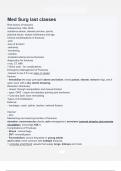STUVIA 2024/2025
Med Surg last classes
Risk factors of fractures
osteoporosis, falls, MVA,
substance abuse, disease process, sports,
physical abuse, lactose intolerance and age
Clinical manifestations of fractures
-pain
-loss of function
-deformity
-shortening
-crepitus
-localized edema and ecchymosis
diagnostics for fractures
x-ray, CT, MRI
> Bone scan - for complications
Emergency Management of Fractures
-Assess to see if it is an open or closed
fracture
- Immobilize the body part-splint above and below, check pulses, elevate, remove rings, and if
%
open cover with a dry, sterile dressing.
Reduction (fractures)
- closed: through manipulation and manual traction
- open: ORIF - repair and stabilize (pinning and hardware)
> Cast and Split: bone remodeling
Types of immobilization
External
- bandages, casts, splints, traction, external fixators
Internal
- pins
Maintaining and restoring function of fractures
elevation, neurovascular checks, pain management, exercises (prevent atrophy and promote
circulation), encourage ADL’s
Complications of Fractures
- Shock - hemorrhage
- DVT- immobilization
- Fat embolism: occurs frequently in young adults
and in men; more common with multiple fractures.
> occludes small blood vessels that supply lungs, kidneys and more
stuvia
, STUVIA 2024/2025
> onset: 12-72 hrs of injury but up to 10 days post injury
Sxs of fat embolism:
Hypoxemia, neurological
compromise and petechial rash
- Respiratory: crackles and wheezing, dyspnea,
chest pain, cough, large amounts of thick white
sputum (snowstorm infiltrate)
- Systemic- pale petechiae (due to thrombocytopenia) in buccal membranes, conjunctival sac,
chest and axillary folds - free fat in the urine
Prevention of fat emoblism
- immobilize fracture ASAP,
- respiratory support: mechanical ventilation,
- corticosteroids IV to treat inflammatory lung reaction and control cerebral edema.
- Vasopressor for hypertension, shock and pulmonary edema.
compartment syndrome
a sudden and severe decrease in blood flow to the tissues distal to an area of injury that results in
ischemic necrosis if prompt, decisive intervention does not occur.
sxs of compartment syndrome
deep, throbbing, unrelenting pain (intensifies with passive ROM)
compartment syndrome causes
%
poor fitting cast, edema, hemorrhage
Compartment syndrome assessment and management
- Assessment: 5 P’s- pain, paralysis,
paresthesias, pallor and pulselessness
- Management: Call MD ASAP, position extremity at the heart level
> enhance arterial perfusion and control edema, open and
bivalving the cast or open the splint.
- If pressure not relieved, fasciotomy.
Hazards of immobility
constipation, renal
calculi, pneumonia, P.E. decubitus: active &
passive ROM; use of trapeze
Hip fractures prevention
Increased CA- 1 gram-
premenopausal; 1500 mg-post also adequate Vit. D, regular weight bearing exercise,
modification of lifestyle
Post-menopausal bone loss prevention
Fosamax, Actonel
> increases bone mass
Statins
stuvia




